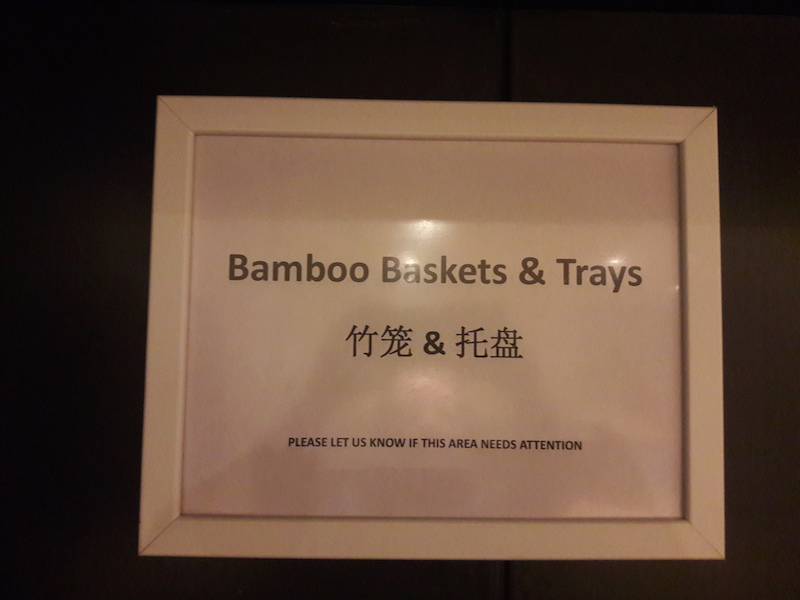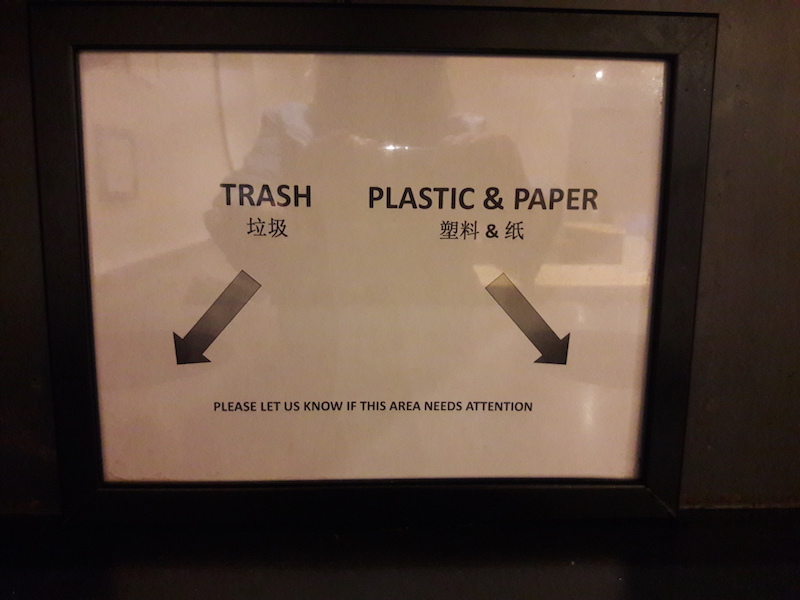Ampersand in Chinese
« previous post | next post »
From Caitlin Schultz:
I was eating at a place called Yaso Tangbao in Midtown Manhattan recently and snapped these photos of Chinese characters and ampersands. I thought it was unusual!
Here's what the signs say in Chinese:
zhúlóng & tuōpán 竹笼 & 托盘 ("bamboo baskets & trays")
lājī (PRC) / lèsè (Taiwan), sùliào & zhǐ 垃圾, 塑料 & 纸 ("trash, plastic & paper")
píngzi & guànzi 瓶子 & 罐子 ("bottles & cans")
There's no problem with the translations. The question is how to pronounce the ampersand.
The 卍 has already been present for four to five thousand years in territory that is now part of western China. Later, around four thousand years ago, it was reintroduced with Buddhism and also taken up by Taoism. We know how to pronounce it, viz., wàn. It can mean "swastika" or "ten thousand".
Ditto for "Q", "X", and many other originally non-Sinitic symbols that have been absorbed into the Chinese writing system.
Among other readings on this subject, see:
- "Creeping Romanization in Chinese" (8/30/12)
- "New radicals in an old writing system" (8/29/12)
- "Zhao C: a Man Who Lost His Name" (2/27/09)
- "A New Morpheme in Mandarin"
- Mark Hansell, "The Sino-Alphabet: The Assimilation of Roman Letters into the Chinese Writing System," Sino-Platonic Papers, 45 (May, 1994), 1-28.
- LIU Yongquan (Institute of Linguistics, Chinese Academy of Social Sciences), "On the Problem of Chinese Lettered Words, Sino-Platonic Papers, 116 (May, 2002).
The earliest character I know of was introduced from the West more than four millennia ago:
☩ > wū 巫 ("shaman; witch, wizard; magician"), Old Sinitic *myag, a loanword from Old Persian *maguš ("magician; magi")
References
Mair, Victor H. 2012. "The Earliest Identifiable Written Chinese Character.” In Archaeology and Language: Indo-European Studies Presented to James P. Mallory, ed. Martin E. Huld, Karlene Jones-Bley, and Dean Miller. JIES Monograph Series No. 60. Washington, D.C.: Institute for the Study of Man. Pp. 265–279.
__________. 1990. "Old Sinitic *Myag, Old Persian Maguš and English Magician", Early China 15: 27–47.
Since the Chinese writing system is open-ended, there's no reason why symbols like "&" cannot become a part of it, but people who use them must have an associated sound in their mind when they write them down.



martin schwartz said,
August 9, 2018 @ 11:52 pm
There are much earlier instances of cross-script ampersands" of westerly origin coming on Chinese soil, tho not into Chinese script. As I noted ca. 1968 in my PhD dissertation (I think), Turfan Christian Sogdian manuscripts, in Syriac script, attest two stereotyped form of the abbreviated Sogdian script Aramæogram ZY = at(i) 'and', one instance of which in Syriac script looks like 'ayin + y (misinterpreted as gamma + y), and the other looks like Syriac yz. These parallel our own ampersand, which originated as a quikwrite of Latin et in medieval hands; cf. &c = etc.
Martin Schwartz
Mike Ayers said,
August 10, 2018 @ 12:50 am
I would anticipate it be pronounced "hé" or "and", as I expect the signmaker was bilingual. Using European style symbols in Chinese chat seems to be a bit of a trend, if only because they're right there on the phone keyboard. I think this is merely a chat-ism leaking out. Will this remain? I kinda hope not.
Note also that there is a strong American current of using letters and symbols in creative ways, so this could just be purely for the locals..?
David Marjanović said,
August 10, 2018 @ 5:38 am
What is *myag in Baxter/Sagart? *mak?
Philip Taylor said,
August 10, 2018 @ 9:24 am
"Since the Chinese writing system is open-ended, there's no reason why symbols like "&" cannot become a part of it, but people who use them must have an associated sound in their mind when they write them down". Is this necessarily (and universally) true ? Do (for example) people who have been totally deaf from birth "have an associated sound in their mind" when they write things down ?
Anarcissie said,
August 10, 2018 @ 10:12 am
There is a lot of disagreement about the supposed sound of '#': among others, 'pound', 'number', or 'sh' as in Nerdish '#!', pronounced 'sh-bang' (an element in shell scripts).
Victor Mair said,
August 10, 2018 @ 10:49 am
Neil Kubler sent in this photo of a store sign he took in Nanjing last year. Neil writes, "I've asked various locals how this ampersand is pronounced — some say 'he2', some say 'yu3', some say 'and'."
VHM: The sign says "Kèyī shūdiàn & Kèyī huàláng 可一书店&可一画廊 (Keyi Bookstore & Keyi Gallery)".
For those who are curious, the bookstore is named after the owner's daughter. The meaning of her name is explained in the first of these two articles introducing the bookstore and its namesake.
http://www.jsfxw.com/sjsd/sdjs.asp?id=14
http://www.sohu.com/a/218584524_364179
Chris Button said,
August 10, 2018 @ 10:59 am
@ David Marjanović
Baxter & Sagart reconstruct 巫 as *C.m(r)[o] as an open syllable. Zhengzhang and Schuessler have the far simpler *ma. Following Pulleyblank, I would go with *maɣ (or more specifically *màɣ with the grave accent noting the "Type-B" syllable). The velar coda /ɣ/ better supports Prof. Mair's proposal for an association with Old Persian *maguš. Pulleyblank's /ɣ/ (or /ɰ/) corresponds with earlier reconstructions with /g/ although Li Fang-Kuei notably commented even then that it was probably not a stop per se. Its complete removal in more recent systems to be replaced by open syllables has unfortunately thrown the baby out with the bath water (compare 來 *rə́ɣ with 麥 *mrə̀k for example).
B.Ma said,
August 10, 2018 @ 12:08 pm
I might pronounce & as 同(埋) in Cantonese, though I believe the character 及 would normally be used instead in Hong Kong if trying to be official.
Ben Olson said,
August 10, 2018 @ 3:25 pm
I saw it in Japanese recently with the characters in the new Super Smash Bros. game.
There's a two character team called ロゼッタ&チコ which is odd, because "and" in Japanese is usually expressed with と.
David Marjanović said,
August 11, 2018 @ 3:44 am
Except for lacking the preinitial consonant, that's not simpler; it merely expresses less uncertainty. "(r)" means Baxter & Sagart find it impossible to tell whether a medial *r was present because it would make no difference in the attested reflexes; "[o]" means "*o or something similar", again meaning that Baxter & Sagart find it impossible to choose from a range of options – I'd need to read the book to know what that range is exactly, but I'd be surprised if *a weren't one of the options covered by it.
Li famously reconstructed a stop coda for every syllable, giving us a language with no open syllables at all, which is highly improbable at best. Do you replace all of Li's voiced stop codas with voiced fricatives, or just some of them?
Philip Taylor said,
August 11, 2018 @ 5:07 am
To expand on David M's clarification, what Baxter & Sagart say concerning their Old Chinese reconstruction is as follows :
Kelly said,
August 11, 2018 @ 5:36 am
Don't need to look for bookshop in specific city… H&M in various places and it is pronounced "and"…. When the & appears in other context then use the same….
Andreas Johansson said,
August 11, 2018 @ 7:14 am
@Kelly?
Chinese people speaking Chinese pronounce the ampersand in H&M as "and"? If so, I can't help but find it rather funny.
Philip Taylor said,
August 11, 2018 @ 7:51 am
I think it is not unreasonable (or unlikely) that "Chinese people speaking Chinese" might pronounce the ampersand in "H&M" as /ænd/ but whether the majority would do the same in (e.g.,) "竹笼 & 托盘" is at best moot and probably false.
Chris Button said,
August 11, 2018 @ 7:53 am
@ David Marjanović
Actually Li didn’t “famously” do anything of the sort: firstly, by “stopped”, I think you mean “closed”; secondly, by including the voiced stops -d and -g (he did not reconstruct -b), he was simply following other scholars in the field. The voiced stop hypothesis has now been convincingly discredited, but the evidence lying behind such erroneous reconstructions has not simply disappeared.
Regarding the OC syllable, in terms of phonetics or surface phonology, then of course open syllable must have existed. In terms of deep underlying phonological structure in a vertical vowel (or vowelless) reconstruction (i.e. not one solely based on statistically valid surface rhyming tendencies), then there are semi-vowels / glides in coda position for what on the surface may be "open" in certain syllables in other more "surfacey" reconstructions. To be more specific about Li’s -g, in his OC Loanwords in Tai (1945) article he assumes a shift of -əg > -əɣ > -əɯ; Pulleyblank does not assume the earlier stopped phase and treats Li’s vocalic /ɯ/ as the velar glide /ɰ/ instead (or lightly fricated /ɣ/).
Chris Button said,
August 11, 2018 @ 5:09 pm
At least from the perspective of the Shijing rhymes while noting xiesheng evidence for its earlier existence.
Mike Ayers said,
August 12, 2018 @ 5:16 pm
Philip Taylor said,
> I think it is not unreasonable (or unlikely) that "Chinese people speaking Chinese" might pronounce the ampersand in "H&M" as /ænd/ but whether the majority would do the same in (e.g.,) "竹笼 & 托盘" is at best moot and probably false.
I agree upon the specifics of pronunciation of "&", but I would indeed expect many Chinese to be using an approximation of "and" constructed of sounds from their own dialect[1]. I would also expect the usage of the local additive conjunction, with ratio being tied to cultural and generational factors.
For example, I pronounce "resume" differently depending on whether it means "to continue" or "list of credentials", the latter meaning imported from French. My pronunciation of the latter is not correct for French, the "loan word" is now an English word in its own right. I don't see how this ampersand would be any different.
[1] I'm not sure if this is the correct word. I still haven't reconciled my understanding of the Chinese language (family?).
Junli Xiao said,
August 12, 2018 @ 10:29 pm
I'm from Taiwan. The same thing happens a lot in Taiwan, too.
I'd rather say people borrow the symbol "&" from English (and combine it with Chinese) just because that would look exotic and stylish, and few people care about and have an idea of its pronunciation.
Philip Taylor said,
August 13, 2018 @ 2:57 am
(Junli) But do they not internalise the sound of what they are writing ? This is, I think, what Victor had in mind when he wrote "Since the Chinese writing system is open-ended, there's no reason why symbols like "&" cannot become a part of it, but people who use them must have an associated sound in their mind when they write them down", and although I queried whether it is universally true (e.g., does it apply to those totally deaf since birth), I very much suspect that he was completely correct for those of us with normal or semi-normal hearing …
Philip Taylor said,
August 13, 2018 @ 3:19 am
Mike A: Yes, I over-stated my case when I wrote '"Chinese people speaking Chinese" might pronounce the ampersand in "H&M" as /ænd/'. Only those who are bi-lingual might accurately reproduce /ænd/ while others might approximate to it in a manner consistent with local phonology. A monolingual Mandarin speaker might, for example, say /æn/, since there are (as far as I know) no Mandarin words that end /nd/. Interestingly, the Wikipedia article on Standard Chinese phonology does not admit of /æ/ as a native vowel, but it is nonetheless the vowel sound that I think I hear when most native speakers pronounces 三 (sān). Perhaps Victor or another Sinitic expert could comment on this last point.
Ellen K. said,
August 13, 2018 @ 9:08 am
Seems to me a Chinese speaker saying /ænd/ or /æn/ for "&" would not be pronouncing it as we typically do in English. A phrase with an "&" would likely have, where the "&" is, a reduced vowel or no vowel, and no d sound. I would say I'm most likely to use a syllabic /n/. While "and" might get a full /ænd/ pronunciation while reading, "&" is unlikely to.